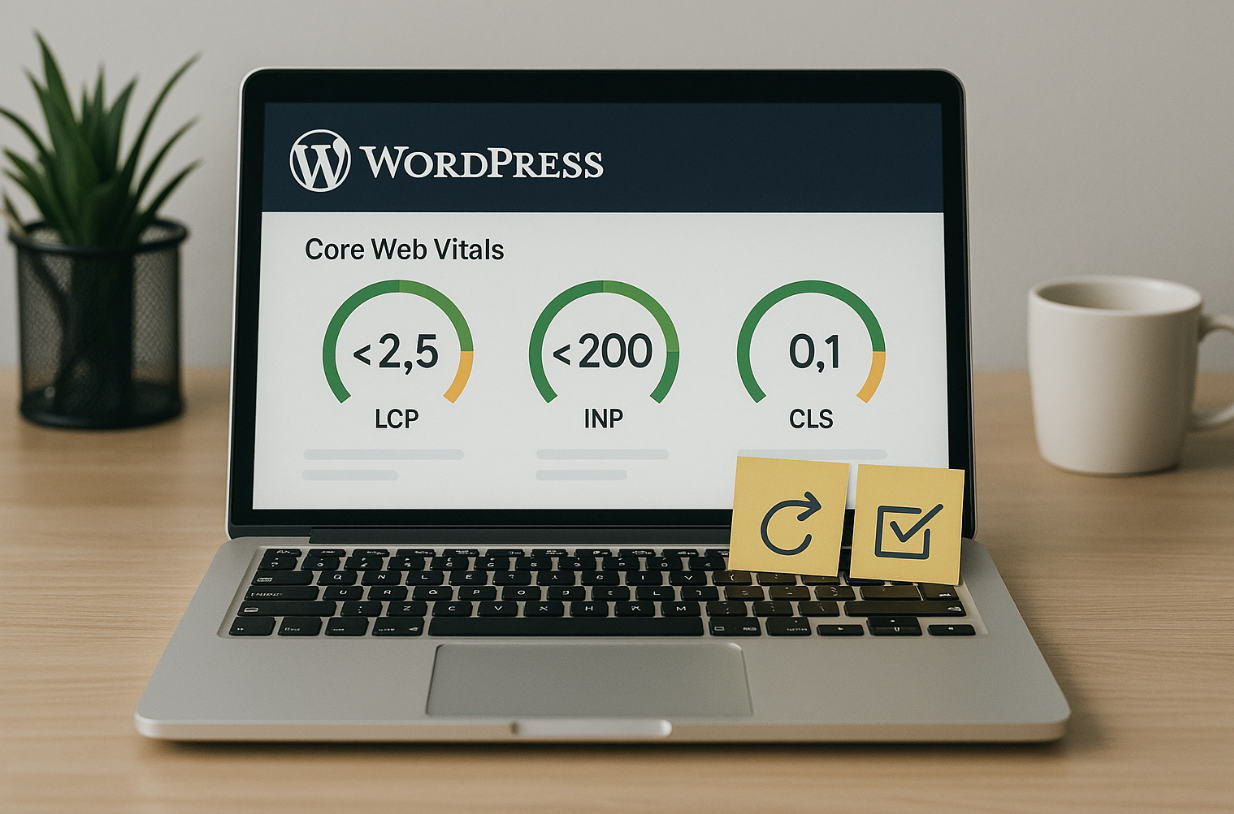
Introduction
Most new WordPress guides focus on themes and design first. A better approach starts with performance goals, settings, and simple rules that protect speed from day one. Core Web Vitals, Largest Contentful Paint, Interaction to Next Paint, and Cumulative Layout Shift, measure how quickly a page shows useful content, how promptly it responds, and how stable the layout feels. This guide explains a clean setup that keeps scores healthy as content grows.
Create a performance budget first
A performance budget is a small set of numbers that guides every decision. It prevents slowdowns before they happen.
- Largest Contentful Paint target, under 2.5 seconds for typical pages on a mobile connection.
- Interaction to Next Paint target, under 200 milliseconds for user interactions on key pages.
- Cumulative Layout Shift target, under 0.1 for visible stability.
- Page weight guardrail, for example images on a page stay under a combined 1 to 1.5 MB.
Write this budget in a readme file and review it before adding any plugin, font, or script.
Install WordPress with a clean baseline
Start with a modern block theme and an empty front page. Avoid demo content packs. Keep the initial plugin list small, only what is required for security, forms, and backups. Fewer moving parts means fewer layout shifts and faster response.
Theme checklist
- Choose a block theme that uses patterns instead of heavy page builders.
- Keep the home page simple, a hero, a headline, and a brief paragraph.
- Set a readable system font stack at first to avoid blocking text.
Plugin checklist
- Add only high quality plugins that solve a real need.
- Remove unused plugins and delete their data.
- Update on a weekly cadence so fixes and optimizations land quickly.
Core Web Vitals settings in the dashboard
Several default choices influence speed and stability.
- Enable automatic updates for minor releases to receive performance improvements.
- Turn off features that add large scripts until they are truly needed.
- Keep the number of active plugins lean to reduce long tasks in the browser.
- Use a lightweight home page template for the first publish.
Images policy for speed
Images are often the largest files on a page. A simple policy preserves quality without hurting performance.
- Use AVIF or WebP formats where practical. Fall back to JPEG or PNG only when needed.
- Generate multiple sizes so WordPress can serve the correct size for each viewport.
- Compress images before upload and avoid oversized hero images.
- Lazy load images that are below the initial viewport.
Fonts that do not block rendering
Fonts can slow the first paint or cause layout jumps.
- Limit the number of families and weights.
- Use a system font stack during the initial build, switch to a custom font only after speed is measured.
- Set font display to a value that avoids invisible text.
- Preload only the single critical font file used in the first viewport.
Measurement plan from day one
Measure in a repeatable way after each change. Use a simple checklist, home page, a key article page, and a contact page.
- Run lab tests to estimate performance on a mobile profile.
- Compare field data to understand how real users experience the site.
- Track LCP, INP, and CLS for the same pages after every major update.
For clear explanations of Core Web Vitals concepts and targets, review the learning paths at the following official resource.
https://web.dev/explore/learn-core-web-vitals
Performance Lab starter features
The official Performance Lab plugin, maintained by the WordPress Performance Team, groups experiments that later ship into core. Enable only the modules that match the site setup. Monitor release notes and disable experiments that are no longer needed.
Popular WordPress plugins for speed
Plugin choices should fit the host environment and the theme. Avoid stacking plugins that duplicate features, and measure after each change.
- Page caching. Prefer a host provided cache. If unavailable, select a single caching plugin that integrates with the host and supports preloading.
- Image optimization. Serve modern formats, generate responsive sizes, and compress conservatively to preserve visual quality.
- Asset control. Limit render blocking CSS and JavaScript. Defer noncritical scripts and load features only on the pages that need them.
- Database maintenance. Schedule safe cleanups, and review settings to prevent removal of needed data.
- Content delivery. Use a CDN when it simplifies delivery and reporting, and confirm that metrics remain stable.
For examples of free projects, including WordPress plugins and themes and work in other stacks, see the site below.
https://byalexdavid.com
Caching basics you actually need
Caching reduces work for both the server and the browser.
- Page cache stores the final HTML response for anonymous visitors.
- Object cache stores database query results so repeated requests are faster.
- Browser caching and compression reduce network overhead.
- Set up caching after the site design is stable, then verify that dynamic pages still behave correctly.
Common mistakes and quick fixes
- Uploading full resolution images without compression. Fix by resizing and reuploading.
- Loading several font families and many weights. Fix by consolidating to one family and two weights.
- Installing large slider or animation plugins on the home page. Fix by replacing with a simple image or a low motion pattern.
- Running too many plugins for small tasks. Fix by mapping needs to the fewest high quality plugins and removing the rest.
Conclusion
Starting a WordPress site with a defined performance budget, deliberate settings, and a consistent measurement plan protects user experience from the first publish. The result is a site that loads quickly, responds promptly, and avoids distracting layout shifts.
